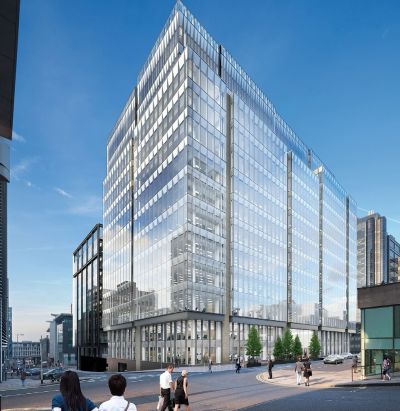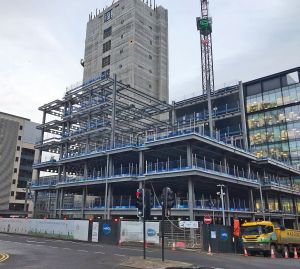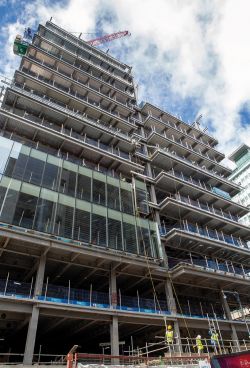177 Bothwell Street, Glasgow
Article in NSC November/December 2020
Steel frames sustainability
Offering around 29,000m2 of Grade A office space, 177 Bothwell Street is set to become Glasgow’s largest and most ambitious office block.
The drive and necessity to construct sustainable buildings is bearing fruit and one commercial scheme in Glasgow is said to be one of the most progressive schemes ever built in the Scottish city. Forming the second part of the wider Bothwell Exchange development - the first part was 122 Waterloo Street - this latest steel-framed commercial block will generate £2.8bn of gross value added (GVA) to the Scottish economy over 25 years, according to an independent economic assessment.
Situated on a plot previously occupied by the Albany Hotel, 177 Bothwell Street is a 14-storey steel-framed structure aiming to achieve a BREEAM 'Excellent’ rating and offering 2,276m2 floorplates and a 743m2 rooftop terrace that includes a 150m-long running track. “Every HFD development has sustainability built into every aspect of the property. That starts with the physical methods and materials used during construction, but it equally applies to the finished product and the way the building is used,” explains Stephen Lewis, Managing Director for HFD Property Group.
To this end, at 177 Bothwell Street, the building’s energy will be provided by 100% renewable energy and technology will be used to make sure the building is used and operates as efficiently as possible. Heat recovery ventilation, solar control glazing, and smart low-energy light systems and controls are just some of the many steps HFD has taken to achieve this. The building will also feature waste recycling facilities, sustainable drainage attenuation systems and advanced energy monitoring and optimisation. It will have electric vehicle charging points and hundreds of bike storage spaces to support sustainable travel.
The company’s rationale extended to the choice of steel for the building’s main frame. “Speed of erection, the ability to achieve longer spans than concrete and therefore create a more open floorplate, together with the sustainability of steel as a recyclable product were the reasons for choosing the material,” explains David Shearer, Managing Director for HFD Construction. “Our steelwork subcontractor has a renewably powered fabrication plant, which was another important consideration.” Steelwork contractor BHC’s investment in sustainability and renewables within its manufacturing facility has allowed the steel for 177 Bothwell Street to have 52% less associated carbon emissions, and it is the first building in Glasgow to have this added sustainability within the structure.
“A hybrid frame of concrete stability core with long span steel floor construction was the logical choice,” adds Woolgar Hunter Project Engineer Jack Dempster. “The steel floorplate can achieve long, clear spans to reduce internal columns, as well as providing good response to footfall vibrations. The hybrid superstructure frame allowed full integration with the services strategy, as well as ensuring a quick and safe construction sequence for the superstructure frame.”
The structure’s columns are arranged around the perimeter on a varied grid of between 6m and 9m, while the typical main span between the core and the front elevation is 17.5m. As open-plan column-free office space was an important design criterion, there are only four internal columns. Therefore, according to Woolgar Hunter, designing the columns for the high axial loads was a challenge. The solution was to employ a combination of plated column sections, European sections and high Grade S460 steel to resist the high loadings. “We worked closely with BHC to ensure that an optimum solution was reached, both regarding steel tonnage and material procurement,” says Mr Dempster.
Although the building’s basement sub-structure and ground floor slab are reinforced concrete, the steel columns are in fact founded at basement level and are supported on piled foundations. The first steel composite floor is at level one. Erecting the lower level steel columns had to be sequenced around the concrete works. The main steelwork erection programme did not fully start until the basement works were complete, which allowed BHC to use the ground floor slab as a safe working platform.
The structure’s stability is derived from the concrete floor slabs, which are supported by metal decking, and thereby create diaphragms to transfer lateral forces to the single concrete core. The core is tied to the floorplates through a combination of connections, including a bespoke plate detail developed between BHC and Woolgar Hunter. The concrete core acts as a vertical cantilever resisting all destabilising loads. The core is also located centrally in the east-west direction and is offset slightly to the rear of the building.
The floor is a 150mm deep reinforced concrete slab, cast onto re-entrant metal decking. This flooring solution is said to have provided a lightweight floor to reduce the load on the long span floor beams, and it did not require any propping in the temporary condition. The slab thickness and decking type were also selected to suit the floor vibration response requirements.
Adding some architectural interest, the perimeter of the building cantilevers throughout its height on each elevation, with the cantilever dimension varying throughout. At levels 11 and 12, the front façade line steps back, and therefore transfer structures are required on these floors. The transfer structures consist of doubled-up plated girders, which are said to have kept the structural depth consistent throughout the floorplate.
The project is being constructed in unusual times due to the global pandemic. In summary, Mr Lewis says: “COVID-19 has prompted us to review the building design and operation of 177 Bothwell Street, ahead of its delivery next year. Factoring in what we know about the virus so far, our review has focussed on a number of aspects of the development, particularly people’s physical interaction with the building, along with the use of technology and amenities. We have removed the need for people to physically touch the building with their hands as far as possible, while taking a range of other steps including a review of ventilation systems and air circulation.”
177 Bothwell Street is set for completion in the third quarter of 2021.
| Architect | Sheppard Robson Architects |
| Structural Engineer | Woolgar Hunter |
| Steelwork Contractor | BHC |
| Main Contractor | HFD Construction |
| Main Client | HFD Property Group |






